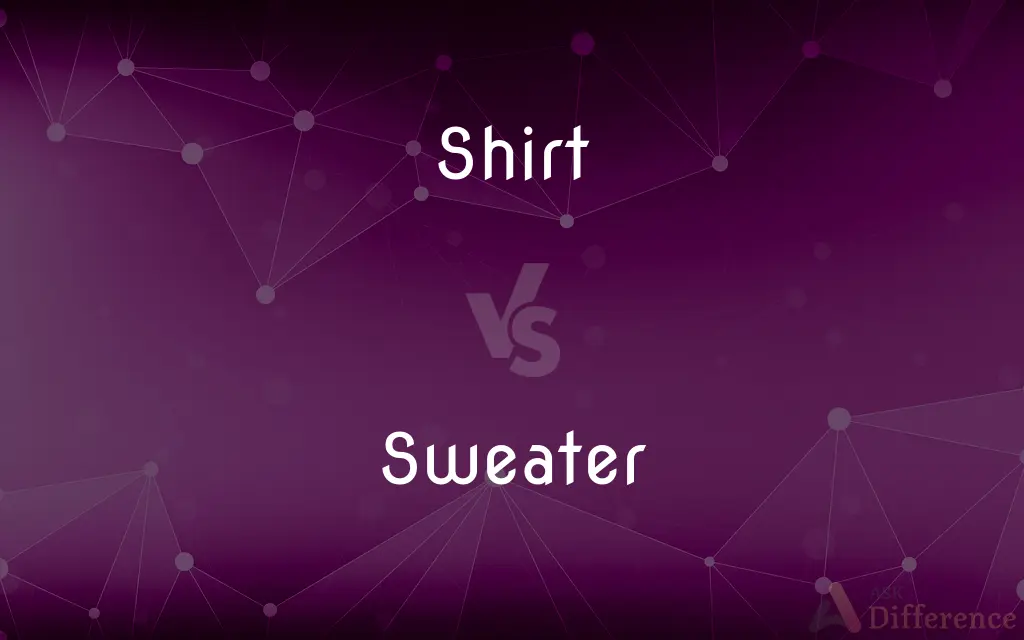Shirt vs. Sweater — What's the Difference?
By Tayyaba Rehman & Urooj Arif — Updated on March 15, 2024
A shirt is a lightweight garment with sleeves and a collar, typically worn as an under or outer layer, while a sweater is a heavier, knitted top designed for warmth, often worn over shirts.

Difference Between Shirt and Sweater
Table of Contents
ADVERTISEMENT
Key Differences
Shirts are usually made from lightweight fabrics like cotton or polyester, designed for comfort and versatility in various settings, from casual to formal. They often feature buttons and a collar, and can come in short or long sleeves. On the other hand, sweaters are knitted garments made from wool, cotton, or synthetic fibers, aimed at providing warmth. They are typically pullover style or may have a front opening, and lack the structured collar of shirts.
While shirts serve as a staple in both casual and formal wardrobes, offering a range of styles including dress shirts and casual button-downs, sweaters are primarily considered casual or business casual wear, suited for cooler weather or layered looks. Sweaters can vary in thickness and knit patterns, with styles like cardigans, crew necks, and V-necks.
Shirts are versatile in their use, often worn alone in warmer climates or under jackets and suits in formal settings. They can be easily dressed up with a tie or blazer. Sweaters, while offering some versatility, are generally more casual and less suitable for formal occasions, serving as a cozy layer over shirts or t-shirts.
The care and maintenance of shirts typically involve regular washing and sometimes ironing to maintain a crisp appearance, especially for dress shirts. Sweaters require more careful handling, with many needing hand washing or special laundry care to avoid damage to the knit fabric.
In terms of fashion and personal expression, shirts offer a wide canvas for patterns, colors, and styles, easily adaptable to changing trends. Sweaters, with their texture and knit patterns, provide a different aesthetic appeal, often associated with comfort and a relaxed style.
ADVERTISEMENT
Comparison Chart
Material
Made from lightweight fabrics like cotton, polyester.
Typically knitted from wool, cotton, or synthetic fibers.
Purpose
Designed for comfort, versatility; suitable for formal and casual wear.
Aimed at providing warmth, generally more casual.
Style Variations
Features buttons, collars; available in short and long sleeves.
Includes pullovers, cardigans; lacks structured collars.
Wearability
Can be worn alone or as part of formal attire.
Often worn over shirts for added warmth, less formal.
Maintenance
May require regular washing and ironing.
Needs careful handling, possible hand wash or special care.
Fashion Versatility
Offers a broad range of styles and colors, adaptable to trends.
Provides texture and comfort, less variation in patterns and styles.
Compare with Definitions
Shirt
A garment with a collar, sleeves, and buttons down the front.
He chose a crisp white shirt for the job interview.
Sweater
A knitted garment worn on the upper body for warmth.
She wrapped herself in a cozy sweater as the temperature dropped.
Shirt
Often made of lightweight fabric for everyday wear.
Cotton shirts are perfect for the summer heat.
Sweater
Comes in various styles like cardigans and pullovers.
She prefers V-neck sweaters for their classic look.
Shirt
Can be formal or casual, depending on the design.
His wardrobe ranges from casual tees to formal dress shirts.
Sweater
Often made from wool, cotton, or synthetic fibers.
His woolen sweater kept him warm during the winter hike.
Shirt
Essential in both men's and women's wardrobes.
Her silk shirts add elegance to her business attire.
Sweater
Ideal for layering over shirts or tees.
He layered a thick sweater over his shirt for added warmth.
Shirt
A versatile piece of clothing worn on the upper body.
She has a collection of colorful shirts for every occasion.
Sweater
A staple in cold-weather fashion.
Her collection of colorful sweaters brightens up dreary winter days.
Shirt
A shirt is a cloth garment for the upper body (from the neck to the waist). Originally an undergarment worn exclusively by men, it has become, in American English, a catch-all term for a broad variety of upper-body garments and undergarments.
Sweater
A sweater or pullover, also called a jumper in British and Australian English, and a windcheater in parts of Australia, is a piece of clothing, typically with long sleeves, made of knitted or crocheted material, that covers the upper part of the body. When sleeveless, the garment is often called a slipover or sweater vest.
Shirt
A garment for the upper body made of cotton or a similar fabric, with a collar and sleeves, and with buttons down the front
Tonight he's smartly dressed in shirt and tie
Sweater
A garment for the upper body of wool, cotton, or synthetic yarn, typically knitted, having long sleeves, and worn in cold weather.
Shirt
A garment for the upper part of the body, typically having a collar, sleeves, and a front opening.
Sweater
One that sweats, especially profusely.
Shirt
An undershirt.
Sweater
Something that induces sweating; a sudorific.
Shirt
A nightshirt.
Sweater
A knitted jacket or jersey, usually of thick wool, worn by athletes before or after exercise.
Shirt
An article of clothing that is worn on the upper part of the body, and often has sleeves, either long or short, that cover the arms.
It can take a while to learn how to iron a shirt properly.
Sweater
(US) A similar garment worn for warmth.
Shirt
An interior lining in a blast furnace.
Sweater
One who sweats (produces sweat).
Shirt
A member of the shirt-wearing team in a shirts and skins game.
Sweater
One who or that which causes to sweat.
Shirt
To cover or clothe with a shirt, or as if with a shirt.
Sweater
A diaphoretic remedy.
Shirt
To cover or clothe with a shirt, or as with a shirt.
Sweater
(historical) An exploitative middleman who subcontracted piece work in the tailoring trade.
Shirt
A garment worn on the upper half of the body
Sweater
(archaic) One who sweats coins, i.e. removes small portions by shaking them.
Shirt
Put a shirt on
Sweater
A London street ruffian in Queen Anne's time who prodded weak passengers with his sword-point.
Sweater
(transitive) To dress in a sweater.
Sweater
One who sweats.
Sweater
One who, or that which, causes to sweat
Sweater
A crocheted or knitted garment covering the upper part of the body
Sweater
A person who perspires
Common Curiosities
Can sweaters be worn in formal settings?
While generally more casual, certain sweater styles like fine-knit V-necks can be suitable for business casual environments, especially when layered over a dress shirt.
Are all shirts buttoned?
Not all shirts have buttons; some, like T-shirts, are pullover style, but traditionally, shirts refer to garments with buttons and a collar.
How should I care for my sweaters to avoid damage?
Follow the care label instructions, typically involving gentle washing, avoiding high heat, and laying flat to dry to maintain shape and texture.
Can sweaters have buttons?
Yes, cardigan sweaters feature a buttoned or zippered front, making them easy to wear and versatile for layering.
Is a polo shirt considered a shirt or a sweater?
A polo shirt is considered a shirt, characterized by its collar and placket with two or three buttons, usually made of knitted cotton.
What's the difference between a sweater and a sweatshirt?
A sweater is knitted and designed for warmth, while a sweatshirt is made of heavier cotton fabric, often fleece-lined, intended for casual wear or athletic purposes.
Are there specific occasions when wearing a shirt is more appropriate than a sweater?
Yes, formal events and business settings often require a shirt, possibly with a tie and jacket, as sweaters may be too casual.
How do fashion trends affect shirts and sweaters?
Fashion trends can influence the design, colors, and patterns of both shirts and sweaters, though shirts may see more variation due to their wide use in different settings.
Are shirts suitable for all seasons?
Yes, shirts are versatile garments suitable for all seasons, with fabric weight and sleeve length varying to accommodate different weather conditions.
Can sweaters be part of a layered outfit?
Absolutely, sweaters are ideal for layering, especially over shirts or tees, providing both style and warmth in cooler temperatures.
What's the significance of sweater knit patterns?
Knit patterns can add texture and visual interest to sweaters, with different patterns offering varying degrees of warmth and style.
Are sweaters only for winter wear?
While ideal for cold weather, lightweight sweaters can be worn in cooler parts of spring and autumn for added warmth without bulk.
Do shirts offer thermal insulation like sweaters?
Shirts, especially those made from thin fabrics, provide less insulation compared to sweaters, which are designed for warmth.
Can I wear a sweater without anything underneath?
While possible, it's usually more comfortable to wear a light layer, like a T-shirt or shirt, underneath a sweater to prevent itchiness and facilitate ease of movement.
How do I choose between a shirt and a sweater for an outfit?
Consider the occasion, weather, and desired level of formality; shirts are versatile for most settings, while sweaters are best for casual wear and cooler temperatures.
Share Your Discovery

Previous Comparison
Rollneck vs. Turtleneck
Next Comparison
Summons vs. SubpoenaAuthor Spotlight
Written by
Tayyaba RehmanTayyaba Rehman is a distinguished writer, currently serving as a primary contributor to askdifference.com. As a researcher in semantics and etymology, Tayyaba's passion for the complexity of languages and their distinctions has found a perfect home on the platform. Tayyaba delves into the intricacies of language, distinguishing between commonly confused words and phrases, thereby providing clarity for readers worldwide.
Co-written by
Urooj ArifUrooj is a skilled content writer at Ask Difference, known for her exceptional ability to simplify complex topics into engaging and informative content. With a passion for research and a flair for clear, concise writing, she consistently delivers articles that resonate with our diverse audience.













































